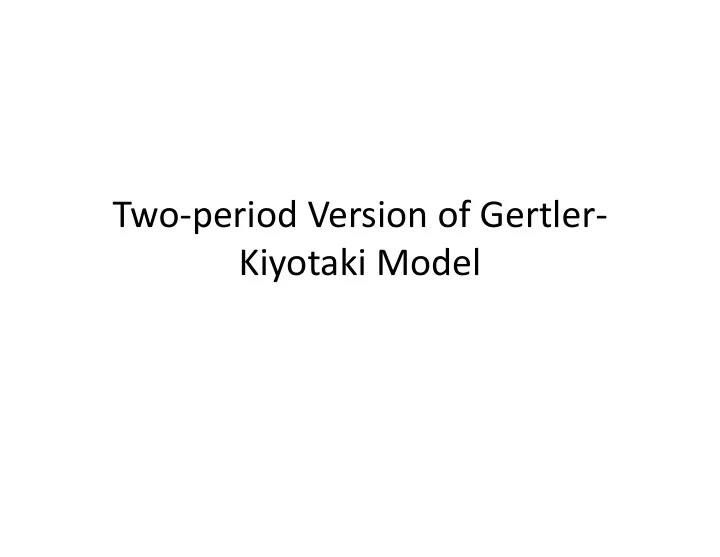

Two ‐ period Version of Gertler ‐ Kiyotaki Model
Risk spread, BAA rated versus AAA rated Bonds 3 Ri k Risk spreads became extraordinarily high d b t di il hi h in late 2008, higher than seems easy to explain based on observed default risk 2.5 2009Q1 annum 2 ercent, per 2008Q1 1.5 pe 1 0.5 1955 1960 1965 1970 1975 1980 1985 1990 1995 2000 2005 year
Puzzle of Interest Rate Spreads • Very high in late 2008, higher than seems explicable with default risk. • Two explanations: Two explanations: – Liquidity: Kiyotaki ‐ Moore/Moore • Banks with cash reluctant to use it to buy firm assets • Afraid they’ll need the cash themselves, and the resale market for firm assets would dry up. • Classic financial market multiple equilibrium • Classic financial market multiple equilibrium phenomenon (Bagehot) – Fear of out ‐ of ‐ equilibrium default (Gertler ‐ Kiradi, Gertler ‐ Kiyotaki).
Two ‐ period Version of GK Model • Many identical households, each with a unit measure of members: – Some members are ‘bankers’ – Some members are ‘workers’ – Perfect insurance inside households…workers and bankers consume same amount! • Period 0 – Workers endowed with y goods, household makes deposits in a bank – Bankers endowed with N goods, take deposits and purchase securities from a firm. – Firm issues securities to finance capital used in production in period 1. i d 1 • Period 1 – Household consumes earnings from deposits plus profits from b banker. k – Goods consumed are produced by the firm.
Problem of the Household period 0 period 1 budget constraint c d ≤ y C ≤ R d d max d , c h , c H u c u C problem S l ti Solution to Household Problem t H h ld P bl u ′ c u ′ C R d c R d ≤ y C R d y c 1 − u c c Rd 1 1 − 1 1 Rd 1 Rd
Efficient Benchmark Problem of the Bank period 0 i d 0 period 1 i d 1 pay dR d to households take deposits, d buy securities, s N d receive sR k from firms problem: max d sR k − R d d problem: max d sR R d
Properties of Efficient Benchmark Equilibrium : R d , c , C , d , (i) household problem solved (i) household problem solved (ii) bank problem solved (iii) market clearing (iii) market clearing • Properties: – Household faces true social rate of return on saving: h ld f l f R k R d – Equilibrium is ‘first best’, i.e., solves max c C k u c u C max c , C , k , u c u C c k ≤ y N , C ≤ kR k
Friction • bank combines deposits, d , with net worth, N , to purchase N+d securities from firms. • bank has two options: N d R k k – (‘no ‐ default’) wait until next period when R d d arrives and pay off depositors, , for profit: N d R k − R d d N d – (‘default’) take securities, leave banking ( ) , g forever, refuse to pay depositors and wait until next period when securities pay off: N d R k
Incentive Constraint • Bank will choose ‘no default’ iff no default default N d R k − R d d ≥ N d R k • Rewriting the above expression the no default • Rewriting the above expression, the no default condition is equivalent to: 1 − N d R k ≥ dR d 1 N d R ≥ dR – i.e., banker doesn’t default if defaulting implies the return for depositors goes up. the return for depositors goes up. • Default will never be observed, because depositors would never put their money in a p p y bank that violates the deposit condition.
Collapse in Net Worth • No default condition: no default default N d R k − R d d ≥ ≥ N d R k N N d R k d R k R d d R k R d • When condition is non ‐ binding, then and NR k ≥ N d R k . N d R k NR k • If N collapses, then constraint may be violated for R d R k d associated with d associated with R R – Equilibrium requires lower value of d R d R k – Lower d requires a spread: – Lower d is not efficient
Policy Implications • Inject equity into banks – Government raises taxes and uses equity to become part ‐ owner in the bank. – This directly increases intermediation, plus may allow additional deposits if households less afraid of default option with government in charge. i i h i h • Make direct loans to non ‐ financial firms – Hard to interpret in the model, because unique advantage of banks doing the intermediation is not made explicit. • Make loans to banks. – Government may have an advantage here because it’s h harder for banks to ‘steal’ from the government d f b k t ‘ t l’ f th t
Directions Directions • Gertler ‐ Kiyotaki place model inside dynamic DSGE model. • Nominal frictions could be added to the model. model.
Recommend
More recommend